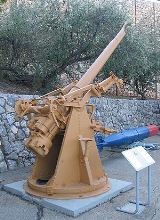
QF 3 inch 20 cwt
Encyclopedia
The QF 3 inch 20 cwt anti-aircraft gun became the standard anti-aircraft gun used in the home defence of the United Kingdom against German airships and bombers and on the Western Front in World War I
. It was also common on British warships in World War I
and submarines in World War II
. 20 cwt
referred to the weight of the barrel and breech, to differentiate it from other "3 inch" guns (1 cwt = 1 hundredweight = 112 lb, hence the barrel and breech together weighed 2250 lb). While other AA guns also had a bore of 3 inches, the term "3 inch" was only ever used to identify this gun in the World War I era, and hence this is what writers are usually referring to by "3 inch AA gun".
naval 3 inches (76.2 mm) QF gun with modifications specified by the War Office
in 1914. These (Mk I) included the introduction of a vertical sliding breech-block to allow semi-automatic operation. When the gun recoiled and ran forward after firing, the motion also opened the breech, ejected the empty cartridge and held the breech open ready to reload, with the striker cocked. When the gunner loaded the next round, the block closed and the gun fired.
The early 12.5 lb (5.7 kg) shrapnel shell at 2500 ft/s (762 m/s) caused excessive barrel wear and was unstable in flight. The 1916 16 lb shell at 2000 ft/s (609.6 m/s) proved ballistically superior and was better suited to a high explosive filling.
The Mark I* had different rifling. The Mark II lost the semi-automatic action.
The Mk III of 1916 reverted to a 2-motion screw breech to suit available manufacturing capability, and Mk IV had a single-tube barrel and single-motion screw breech; a Welin breech block
with an Asbury breech.
A US Army report on anti-aircraft guns of April 1917 reported that this gun's semi-automatic loading system was discontinued because of difficulties of operation at higher angles of elevation, and replaced by "the standard Vickers-type straight-pull breech mechanism", reducing rate of fire from 22 to 20 rds/minute. Routledge quotes a rate of fire of 16-18 rounds per minute, in the context of the 16 pounder shell of 1916. This would appear to be the effective rate of fire found to be sustainable in action.
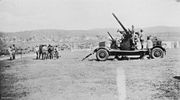 Beginning in 1930, a new towed 4-wheeled sprung trailer platform was introduced to replace the obsolete lorries still used as mounts from World War I, together with modern new barrels, and equipment to connect the guns to the new Vickers No. 1 Predictor.
Beginning in 1930, a new towed 4-wheeled sprung trailer platform was introduced to replace the obsolete lorries still used as mounts from World War I, together with modern new barrels, and equipment to connect the guns to the new Vickers No. 1 Predictor.
8 more Mks followed between the World Wars. By 1934 the rocking-bar deflection sights had been replaced by Magslip receiver dials which received input from the Predictor, with the layers matching pointers instead of tracking the target. Predictor No. 1 was supplemented from 1937 by Predictor No. 2, based on a US Sperry AAA Computer M3A3. This was faster and could track targets at 400 mi/h at heights of 25000 ft (7,620 m), both Predictors received height data, generally from the Barr & Stroud UB 7 (9 feet base) instrument.
The 3 inch 20 cwt gun was superseded by the QF 3.7 inch AA gun
from 1938 onwards but numbers of various Marks remained in service throughout World War II
. In Naval use it was being replaced in the 1920s by the QF 4 inch Mk V
on HA (high-angle) mounting.
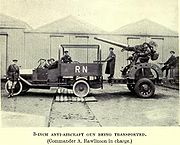
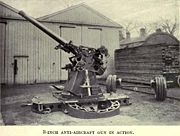
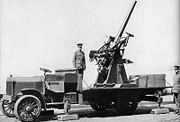
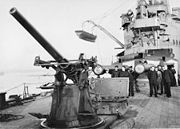 Britain entered World War I
Britain entered World War I
with no anti-aircraft artillery. When war broke out and Germany occupied Belgium and North-east France, it was realised that key installations at home could be attacked by air, the government began a search for suitable anti-aircraft guns. The Navy provided the initial 3 inches (76.2 mm) guns from its warships, approximately 18 by December 1914, for the defence of key installations in Britain, manned by RNVR crews, until the new specialised anti-aircraft version began production and entered service. It was from then onwards operated by Royal Garrison Artillery
crews, with drivers and crew for motor lorries provided by the Army Service Corps.
Other earlier anti-aircraft guns based on the existing 13 pounder
and 18 pounder
guns proved inadequate, apart from the QF 13 pounder 9 cwt
but even that could not reach high altitudes and fired a fairly light shell. The 3 inch 20 cwt with its powerful and stable in flight 16 lb (7.3 kg) shell and fairly high altitude was well suited to defending the United Kingdom against high-altitude Zeppelin
s and bombers. The 16 pound shell took 9.2 seconds to reach 5000 ft (1,524 m) at 25° from horizontal, 13.7 seconds to reach 10000 ft (3,048 m) at 40°, 18.8 seconds to reach 15,000 at 55°. This means that the gun team had to calculate where the target would be 9 – 18 seconds ahead, determine the deflection and set the correct fuze length, load, aim and fire accordingly. Deflection was calculated mechanically and graphically using an optical height & rangefinder to provide data for the two piece Wilson-Dalby 'predictor', with the fuze length read of a scale mounted on the gun.
British time fuzes, required for airburst shooting, were powder burning (igniferous). However, the powder burning rate changed as air-pressure reduced making them erratic for the new vertical shooting. Modified fuzes reduced the variability but did not cure the problem. Britain lagged behind Germany in developing clockwork time fuzes. In addition, experience showed that the percussion mechanism in time fuzes, which burst the shrapnel shell on impact if the timer failed, had to be removed because AA shells could land among friendly troops and nearby civilians. Igniferous fuzes had to have a gaine in order to detonate HE shells.
The carriage's short recoil of 11 inches (279.4 mm) allowed a higher rate of fire than for AA guns based on long-recoil field guns such as the QF 13 pounder 9 cwt
.
By June 1916, 202 3 inch 20 cwt were deployed in the air defence of Britain, of a total of 371 AA guns.
The first guns arrived on the Western Front
in November 1916 and by the end of 1916 it equipped 10 sections out of a total of 91. An AA section consisted of 2 guns and became the standard organizational unit.
By the end of World War I, 257 (out of a total of 402 AA guns) were in land service in England on static and lorry mountings, and 102 (out of a total of 348) were in service on the Western Front mounted on heavy lorries, typically the Peerless 4 Ton. In addition, many were mounted on Royal Navy ships.
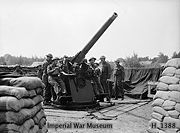 At the beginning of World War II
At the beginning of World War II
in 1939, Britain possessed approximately 500 of these guns. Initially most were in the heavy anti-aircraft (HAA) role until replaced by the new 3.7 inch gun
. Some deployed as light anti-aircraft guns (LAA) for airfield defence, being transferred to the RAF Regiment when this was formed in 1942, until more 40mm Bofors gun
s arrived However, it was discovered at mobilization that the 233 guns in HAA reserve were missing various parts and predicted fire instruments. 120 were in France with the British Expeditionary Force
in November 1939, compared with 48 of the modern QF 3.7 inch AA gun
.
In 1941, 100 of the obsolete guns were converted to become the 3 inch 16 cwt anti-tank gun, firing a 12.5 lb (5.7 kg) armour-piercing shell. They appear to have been mainly deployed in home defence.
the gun was carried by S class
, U class
and V class
submarines.
of 30 November 1939 - March 1940 but they arrived too late to be used. They were used during the Continuation War
of 1941 - 1944.
World War I
World War I , which was predominantly called the World War or the Great War from its occurrence until 1939, and the First World War or World War I thereafter, was a major war centred in Europe that began on 28 July 1914 and lasted until 11 November 1918...
. It was also common on British warships in World War I
World War I
World War I , which was predominantly called the World War or the Great War from its occurrence until 1939, and the First World War or World War I thereafter, was a major war centred in Europe that began on 28 July 1914 and lasted until 11 November 1918...
and submarines in World War II
World War II
World War II, or the Second World War , was a global conflict lasting from 1939 to 1945, involving most of the world's nations—including all of the great powers—eventually forming two opposing military alliances: the Allies and the Axis...
. 20 cwt
Hundredweight
The hundredweight or centum weight is a unit of mass defined in terms of the pound . The definition used in Britain differs from that used in North America. The two are distinguished by the terms long hundredweight and short hundredweight:* The long hundredweight is defined as 112 lb, which...
referred to the weight of the barrel and breech, to differentiate it from other "3 inch" guns (1 cwt = 1 hundredweight = 112 lb, hence the barrel and breech together weighed 2250 lb). While other AA guns also had a bore of 3 inches, the term "3 inch" was only ever used to identify this gun in the World War I era, and hence this is what writers are usually referring to by "3 inch AA gun".
Design and development
The gun was based on a prewar VickersVickers
Vickers was a famous name in British engineering that existed through many companies from 1828 until 1999.-Early history:Vickers was formed in Sheffield as a steel foundry by the miller Edward Vickers and his father-in-law George Naylor in 1828. Naylor was a partner in the foundry Naylor &...
naval 3 inches (76.2 mm) QF gun with modifications specified by the War Office
War Office
The War Office was a department of the British Government, responsible for the administration of the British Army between the 17th century and 1964, when its functions were transferred to the Ministry of Defence...
in 1914. These (Mk I) included the introduction of a vertical sliding breech-block to allow semi-automatic operation. When the gun recoiled and ran forward after firing, the motion also opened the breech, ejected the empty cartridge and held the breech open ready to reload, with the striker cocked. When the gunner loaded the next round, the block closed and the gun fired.
The early 12.5 lb (5.7 kg) shrapnel shell at 2500 ft/s (762 m/s) caused excessive barrel wear and was unstable in flight. The 1916 16 lb shell at 2000 ft/s (609.6 m/s) proved ballistically superior and was better suited to a high explosive filling.
The Mark I* had different rifling. The Mark II lost the semi-automatic action.
The Mk III of 1916 reverted to a 2-motion screw breech to suit available manufacturing capability, and Mk IV had a single-tube barrel and single-motion screw breech; a Welin breech block
Welin breech block
The Welin breech block was a revolutionary stepped, interrupted thread design for locking artillery breeches, invented by Axel Welin in 1889 or 1890...
with an Asbury breech.
A US Army report on anti-aircraft guns of April 1917 reported that this gun's semi-automatic loading system was discontinued because of difficulties of operation at higher angles of elevation, and replaced by "the standard Vickers-type straight-pull breech mechanism", reducing rate of fire from 22 to 20 rds/minute. Routledge quotes a rate of fire of 16-18 rounds per minute, in the context of the 16 pounder shell of 1916. This would appear to be the effective rate of fire found to be sustainable in action.

8 more Mks followed between the World Wars. By 1934 the rocking-bar deflection sights had been replaced by Magslip receiver dials which received input from the Predictor, with the layers matching pointers instead of tracking the target. Predictor No. 1 was supplemented from 1937 by Predictor No. 2, based on a US Sperry AAA Computer M3A3. This was faster and could track targets at 400 mi/h at heights of 25000 ft (7,620 m), both Predictors received height data, generally from the Barr & Stroud UB 7 (9 feet base) instrument.
The 3 inch 20 cwt gun was superseded by the QF 3.7 inch AA gun
QF 3.7 inch AA gun
The 3.7-Inch QF AA was Britain's primary heavy anti-aircraft gun during World War II. It was roughly the equivalent of the German 88 mm FlaK but with a slightly larger calibre of 94 mm and superior performance. It was used throughout World War II in all theatres except the Eastern Front...
from 1938 onwards but numbers of various Marks remained in service throughout World War II
World War II
World War II, or the Second World War , was a global conflict lasting from 1939 to 1945, involving most of the world's nations—including all of the great powers—eventually forming two opposing military alliances: the Allies and the Axis...
. In Naval use it was being replaced in the 1920s by the QF 4 inch Mk V
QF 4 inch Mk V naval gun
The QF 4 inch Mk V gun was a Royal Navy gun of World War I which was adapted on HA mountings to the heavy anti-aircraft role both at sea and on land, and was also used as a coast defence gun.-Naval service:...
on HA (high-angle) mounting.
World War I




World War I
World War I , which was predominantly called the World War or the Great War from its occurrence until 1939, and the First World War or World War I thereafter, was a major war centred in Europe that began on 28 July 1914 and lasted until 11 November 1918...
with no anti-aircraft artillery. When war broke out and Germany occupied Belgium and North-east France, it was realised that key installations at home could be attacked by air, the government began a search for suitable anti-aircraft guns. The Navy provided the initial 3 inches (76.2 mm) guns from its warships, approximately 18 by December 1914, for the defence of key installations in Britain, manned by RNVR crews, until the new specialised anti-aircraft version began production and entered service. It was from then onwards operated by Royal Garrison Artillery
Royal Garrison Artillery
The Royal Garrison Artillery was an arm of the Royal Artillery that was originally tasked with manning the guns of the British Empire's forts and fortresses, including coastal artillery batteries, the heavy gun batteries attached to each infantry division, and the guns of the siege...
crews, with drivers and crew for motor lorries provided by the Army Service Corps.
Other earlier anti-aircraft guns based on the existing 13 pounder
Ordnance QF 13 pounder
The Ordnance QF 13-pounder quick-firing field gun was the standard equipment of the British Royal Horse Artillery at the outbreak of World War I.-History:...
and 18 pounder
Ordnance QF 18 pounder
The Ordnance QF 18 pounder, or simply 18-pounder Gun, was the standard British Army field gun of the World War I era. It formed the backbone of the Royal Field Artillery during the war, and was produced in large numbers. It was also used by British and Commonwealth Forces in all the main theatres,...
guns proved inadequate, apart from the QF 13 pounder 9 cwt
QF 13 pounder 9 cwt
The 13 pounder 9 cwt anti-aircraft gun became the standard mobile British anti-aircraft gun of the World War I era, especially in theatres outside Britain...
but even that could not reach high altitudes and fired a fairly light shell. The 3 inch 20 cwt with its powerful and stable in flight 16 lb (7.3 kg) shell and fairly high altitude was well suited to defending the United Kingdom against high-altitude Zeppelin
Zeppelin
A Zeppelin is a type of rigid airship pioneered by the German Count Ferdinand von Zeppelin in the early 20th century. It was based on designs he had outlined in 1874 and detailed in 1893. His plans were reviewed by committee in 1894 and patented in the United States on 14 March 1899...
s and bombers. The 16 pound shell took 9.2 seconds to reach 5000 ft (1,524 m) at 25° from horizontal, 13.7 seconds to reach 10000 ft (3,048 m) at 40°, 18.8 seconds to reach 15,000 at 55°. This means that the gun team had to calculate where the target would be 9 – 18 seconds ahead, determine the deflection and set the correct fuze length, load, aim and fire accordingly. Deflection was calculated mechanically and graphically using an optical height & rangefinder to provide data for the two piece Wilson-Dalby 'predictor', with the fuze length read of a scale mounted on the gun.
British time fuzes, required for airburst shooting, were powder burning (igniferous). However, the powder burning rate changed as air-pressure reduced making them erratic for the new vertical shooting. Modified fuzes reduced the variability but did not cure the problem. Britain lagged behind Germany in developing clockwork time fuzes. In addition, experience showed that the percussion mechanism in time fuzes, which burst the shrapnel shell on impact if the timer failed, had to be removed because AA shells could land among friendly troops and nearby civilians. Igniferous fuzes had to have a gaine in order to detonate HE shells.
The carriage's short recoil of 11 inches (279.4 mm) allowed a higher rate of fire than for AA guns based on long-recoil field guns such as the QF 13 pounder 9 cwt
QF 13 pounder 9 cwt
The 13 pounder 9 cwt anti-aircraft gun became the standard mobile British anti-aircraft gun of the World War I era, especially in theatres outside Britain...
.
By June 1916, 202 3 inch 20 cwt were deployed in the air defence of Britain, of a total of 371 AA guns.
The first guns arrived on the Western Front
Western Front (World War I)
Following the outbreak of World War I in 1914, the German Army opened the Western Front by first invading Luxembourg and Belgium, then gaining military control of important industrial regions in France. The tide of the advance was dramatically turned with the Battle of the Marne...
in November 1916 and by the end of 1916 it equipped 10 sections out of a total of 91. An AA section consisted of 2 guns and became the standard organizational unit.
By the end of World War I, 257 (out of a total of 402 AA guns) were in land service in England on static and lorry mountings, and 102 (out of a total of 348) were in service on the Western Front mounted on heavy lorries, typically the Peerless 4 Ton. In addition, many were mounted on Royal Navy ships.
Performance
The following table compares the gun's performance with the other British World War I anti-aircraft guns:-| Gun | m/v ft/s | Shell (lb) | Time to 5000 ft (1,524 m) at 25° (seconds) | Time to 10000 ft (3,048 m) at 40° (seconds) | Time to 15000 ft (4,572 m) at 55° (seconds) | Max. height (ft) |
| QF 13 pdr 9 cwt QF 13 pounder 9 cwt The 13 pounder 9 cwt anti-aircraft gun became the standard mobile British anti-aircraft gun of the World War I era, especially in theatres outside Britain... |
1990 | 12.5 | 10.1 | 15.5 | 22.1 | 19,000 |
| QF 12 pdr 12 cwt QF 12 pounder 12 cwt AA gun The 12 pounder 12 cwt anti-aircraft gun was borrowed for AA use from the QF 12 pounder 12 cwt coast defence gun with the addition of a modified cradle for higher elevation, a retaining catch for the cartridge, and an additional spring recuperator above the barrel and high-angle sights. Writers... |
2200 | 12.5 | 9.1 | 14.1 | 19.1 | 20,000 |
| QF 3 inch 20 cwt 1914 | 2500 | 12.5 | 8.3 | 12.6 | 16.3 | 23,500 |
| QF 3 inch 20 cwt 1916 | 2000 | 16 | 9.2 | 13.7 | 18.8 | 22,000 |
| QF 4 inch Mk V naval gun QF 4 inch Mk V naval gun The QF 4 inch Mk V gun was a Royal Navy gun of World War I which was adapted on HA mountings to the heavy anti-aircraft role both at sea and on land, and was also used as a coast defence gun.-Naval service:... |
2350 | 31 | 4.4?? | 9.6 | 12.3 | 28,750 |
World War II

World War II
World War II, or the Second World War , was a global conflict lasting from 1939 to 1945, involving most of the world's nations—including all of the great powers—eventually forming two opposing military alliances: the Allies and the Axis...
in 1939, Britain possessed approximately 500 of these guns. Initially most were in the heavy anti-aircraft (HAA) role until replaced by the new 3.7 inch gun
QF 3.7 inch AA gun
The 3.7-Inch QF AA was Britain's primary heavy anti-aircraft gun during World War II. It was roughly the equivalent of the German 88 mm FlaK but with a slightly larger calibre of 94 mm and superior performance. It was used throughout World War II in all theatres except the Eastern Front...
. Some deployed as light anti-aircraft guns (LAA) for airfield defence, being transferred to the RAF Regiment when this was formed in 1942, until more 40mm Bofors gun
Bofors 40 mm gun
The Bofors 40 mm gun is an anti-aircraft autocannon designed by the Swedish defence firm of Bofors Defence...
s arrived However, it was discovered at mobilization that the 233 guns in HAA reserve were missing various parts and predicted fire instruments. 120 were in France with the British Expeditionary Force
British Expeditionary Force (World War II)
The British Expeditionary Force was the British force in Europe from 1939–1940 during the Second World War. Commanded by General Lord Gort, the BEF constituted one-tenth of the defending Allied force....
in November 1939, compared with 48 of the modern QF 3.7 inch AA gun
QF 3.7 inch AA gun
The 3.7-Inch QF AA was Britain's primary heavy anti-aircraft gun during World War II. It was roughly the equivalent of the German 88 mm FlaK but with a slightly larger calibre of 94 mm and superior performance. It was used throughout World War II in all theatres except the Eastern Front...
.
In 1941, 100 of the obsolete guns were converted to become the 3 inch 16 cwt anti-tank gun, firing a 12.5 lb (5.7 kg) armour-piercing shell. They appear to have been mainly deployed in home defence.
Submarine gun
In World War IIWorld War II
World War II, or the Second World War , was a global conflict lasting from 1939 to 1945, involving most of the world's nations—including all of the great powers—eventually forming two opposing military alliances: the Allies and the Axis...
the gun was carried by S class
British S class submarine (1931)
The S-class submarines of the Royal Navy were originally designed and built during the modernisation of the submarine force in the early 1930s to meet the need for smaller boats to patrol the restricted waters of the North Sea and the Mediterranean Sea replacing the British H class submarines...
, U class
British U class submarine
The British U class submarines were a class of 49 small submarines built just before and during the Second World War...
and V class
British V class submarine
The British V class submarine was a class of submarines built for the Royal Navy during World War II. 42 vessels were ordered to this design, all to be built by Vickers-Armstrong at either Barrow-in-Furness or at Walker-on-Tyne, but only 22 were completed...
submarines.
Finnish use
Britain supplied 24 Mk 3 guns and 7 M/34 mechanical fire control computers to Finland during the Winter WarWinter War
The Winter War was a military conflict between the Soviet Union and Finland. It began with a Soviet offensive on 30 November 1939 – three months after the start of World War II and the Soviet invasion of Poland – and ended on 13 March 1940 with the Moscow Peace Treaty...
of 30 November 1939 - March 1940 but they arrived too late to be used. They were used during the Continuation War
Continuation War
The Continuation War was the second of two wars fought between Finland and the Soviet Union during World War II.At the time of the war, the Finnish side used the name to make clear its perceived relationship to the preceding Winter War...
of 1941 - 1944.
World War I ammunition
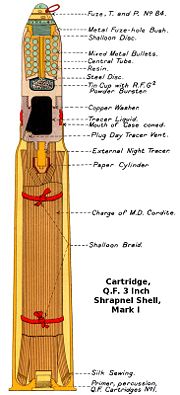 |
 |
 |
 |
See also
- 3-inch M1918 gun3-inch M1918 gunThe 3-inch M1918 gun was a United States 3-inch anti-aircraft gun that entered service in 1918 and served until it was finally superseded by the 90 mm M3 gun just prior to the opening of World War II...
US equivalent - List of anti-aircraft guns
- List of naval anti-aircraft guns
Surviving examples
- At the Royal Artillery Museum, London
- A gun at Pendennis CastlePendennis CastlePendennis Castle is a Henrician castle, also known as one of Henry VIII's Device Forts, in the English county of Cornwall. It was built in 1539 for King Henry VIII to guard the entrance to the River Fal on its west bank, near Falmouth. St Mawes Castle is its opposite number on the east bank and...
, Cornwall, UK - A gun captured by Israel from Egypt in the 1956 war, missing breech screw, is displayed at the Clandestine Immigration and Naval Museum, Haifa, Israel. See Commons:Category:QF 3 inch 20 cwt for photographs.
- A gun from the Egyptian ship "El Amir Faruk", sunk in 1948, missing the elevation mechanism, is displayed at the Clandestine Immigration and Naval Museum, Haifa, Israel. See Commons:Category:QF 3 inch 20 cwt for photographs.
- Mk 3 gun is displayed at the Ilmatorjuntamuseo, Tuusula Finland
- Mk III at Oulu garrison, Intiö district of Oulu, Finland
External links
- British 12-pdr (3"/45 (76.2 cm)) 20cwt QF HA Marks I, II, III and IV
- Ken Musgrave, Diagram of 3 inch 20 cwt gun on Peerless 4 Ton Lorry
- http://www.wwiiequipment.com/3inch.aspx

